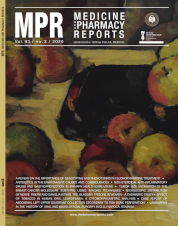Clinico-pathological spectrum of cutaneous sarcoidosis: an experience from a government institute in North India
DOI:
https://doi.org/10.15386/mpr-1384Keywords:
cutaneous sarcoidosis, naked non-caseating granulomas, lymphocyte poorAbstract
Background and aims. Sarcoidosis is a multisystem granulomatous disease of unknown etiology and cutaneous involvement is the second most frequent manifestation in systemic sarcoidosis.
The aim of the present study is to evaluate the clinical and pathological spectrum of cutaneous sarcoidosis and compare the same with literature available.
Methods. The present retrospective study was conducted from January 2010–March 2015 and fifteen cases diagnosed as cutaneous sarcoidosis on biopsy were reviewed. The histological spectrum of cutaneous sarcoidosis was evaluated.
Results. The mean age at diagnosis was 46 years. Nine (60%) cases out of 15 were females. Most common cutaneous lesions were nodules (46.6%) followed by papules (40%). Classically, lymphocyte-poor, non-caseating epithelioid cell granulomas, was the most common histologic finding. Inclusion bodies were seen in 20% cases with occasional presence of fibrinoid necrosis (13.3%). Peri-adnexal granuloma, seen in one case, raised the possibility of tuberculoid leprosy. Foreign body was seen in one case supporting the opinion that sarcoidosis and granulomatous foreign body reaction are not mutually exclusive. Epidermal changes including atrophy, loss of rete pegs, acanthosis, papillomatosis, hyperkeratosis, parakeratosis and basal cell vacuolation were seen in 46.6% cases. Reticulin was positive in all the cases while special stains for acid fast bacilli and fungi were negative.
Conclusion. The clinical presentation of cutaneous sarcoidosis may be variable. Presence of naked, reticulin-rich granulomas is the most characteristic histopathological finding. Correlation of clinical history with histologic examination is essential to exclude other granulomatous diseases including leprosy, syphilis, other infectious granulomatous diseases and foreign body reaction.
Downloads
Published
How to Cite
Issue
Section
License
The authors are required to transfer the copyright of the published paper to the journal. This is done by agreeing to sign the Copyright Assignment Form. Whenever the case, authors are also required to send permissions to reproduce material (such as illustrations) from the copyright holder.

The papers published in the journal are licensed under a Creative Commons Attribution-NonCommercial-NoDerivatives 4.0 International License.

